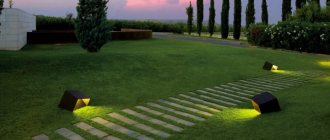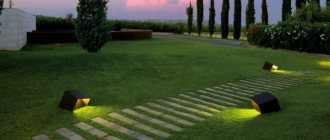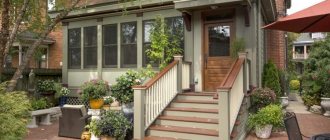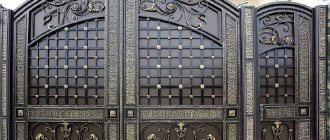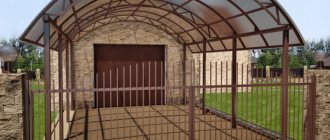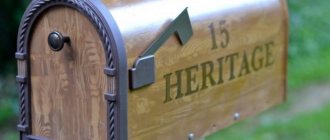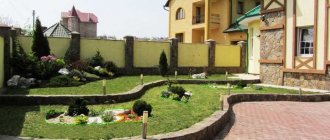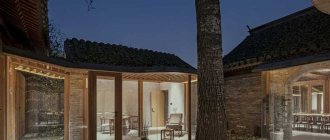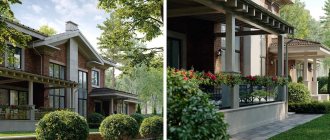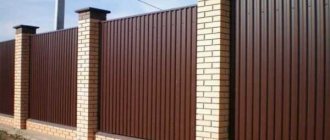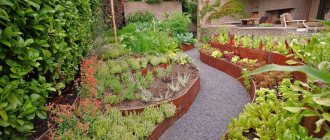Requirements for street lamps
Installation of street light sources involves year-round exposure of lamps and lanterns to a number of meteorological influences.
Taking this factor into account, all purchased lamps must meet a number of requirements:
- Sufficient strength of the products, especially the lampshade.
- Moisture resistant.
- Availability of grounding.
- Ease of practical maintenance of the lamp, especially spring and autumn cleaning.
The photo of the façade lighting shows that all lamps are equipped with durable and moisture-resistant shades.
The shape and design of a garden lamp must fully correspond to the interior of a summer cottage or private house.
Types of local and hidden lighting of buildings
Depending on the direction of light, backlights are divided into several categories, namely:
- Silhouette - expressive outlines of the silhouette of a building are created without detailing. To do this, they use a special luminous background, thanks to which the geometry of a private house is visible, but its facade remains dark.
- Contour – highlighting the contour of a residential building using neon and LED strips installed along the contour of the facade of a private house.
- Color dynamics is a combination of several types of lamps, for example, spotlights with a spotlight or LED strips. Thanks to special programs and modes, you can make the backlight change its light intensity and color palette after a certain time interval. Only professionals can create such lighting, but the costs are worth it.
Types of facade lamps
All commercially available light sources differ in a number of parameters, including size, shape, lamp power, and color temperature.
There are a number of differences in the method of installing decorative lighting:
- The luminaires can be mounted directly into the facades of residential and auxiliary buildings. When choosing such models, you should pay maximum attention to the methods of securing the fastenings.
- Ground lights. Such sources for facade lighting are of particular value. Various models may have support posts, for example, twisted metal or reinforced iron. Small lamps on short stands are placed along garden paths to visually highlight the pedestrian area.
- Hanging models. These include sconces, ceiling chandeliers and lampshades that can illuminate a sufficient area. They are most often used for arrangement on a summer terrace, under a canopy, at the entrance to a house or garage, in a summer kitchen.
- One of the latest trends of the season in landscape design is recessed lighting. These include spotlights that very beautifully emphasize the style of a garden plot and highlight a particular area of the house.
In addition, ground lamps are often used, which are installed directly on the site with green spaces. Such models are equipped with a durable body and are resistant to moisture and temperature changes. It is up to the owner of the garden plot to decide which lamps are best to choose for illuminating facades.
Accent (local) lighting of facades
This is the most common type of lighting decor. It is widely used due to its versatility and is used to decorate buildings and structures of any style.
Accent lighting is used when it is necessary to draw attention to certain elements of the structure.
To do this, highlight the most advantageous and individual details - columns and balconies, window openings and cornices.
Walls lined with metal panels look very impressive in this design.
Local lighting is performed using bright lamps that are attached directly to the facade.
Optimal selection parameters
Purchasing a specific model of luminaires for installing façade lighting requires a detailed approach.
The future owner should pay attention to the following factors:
- Level of protection against moisture and dust. On the product packaging you can find the IP index, which indicates the degree of protection of the product from various external influences.
- The strength of the housing or lampshade, which allows you to place the light source in an open space. The most popular lampshades are made of tempered glass, universal plastic, and lightweight and corrosion-resistant aluminum.
- Type of lamps used. For street lighting, more and more preference is given to LED lamps or halogen lamps, which make it possible to illuminate the courtyard area very effectively, and at the same time, save financial costs on electricity.
- Rating of manufacturing companies. Immediately before purchasing a particular model of façade lamp, you should read the reviews about the manufacturing company.
- Before purchasing a lamp or luminaire, you should carefully inspect it for external damage, cracks, chips, and the presence of wiring insulation.
You should also check with the seller about the product’s maintenance requirements, expected service life, power and presence of a motion sensor.
If installation of the sensor is not provided for in production conditions, you can verify the possibility of self-installation.
Determining factors and work sequence
When developing a lighting plan, consider:
- External features of housing (color, texture, architectural style).
- Landscape of the site, location of the house on it.
- Where is the point from which the house will look best?
After this, you can start creating the project. Preliminary work consists of several stages:
- First, a general lighting concept is developed and lighting fixtures are selected.
- Electrical networks are prepared taking into account the specified lighting and brightness parameters.
- Equipment (lights, lamps, spotlights) is purchased.
The last stage is the actual installation work and launch of the lighting.
Calculation of façade lighting
The first and most important step for the future owner is to calculate the required lighting for the building's facade. This indicator directly depends on the initial area of the garden plot, the size of the load-bearing wall for placing hanging lanterns and lamps, and the presence of a decorative gazebo or other recreation area for the owners.
In addition, the preliminary design must take into account the materials used for exterior finishing in order to install façade lamps. For ground lamps, it is advisable to know the level of soil acidity, which can have a detrimental effect on the base and lampshade material. The calculation is carried out in accordance with the requirements of GOST.
How to calculate façade lighting:
- External architectural lighting should provide good visibility and figurative expressiveness of the most important objects, and the comfort of the light environment, help identify the originality of the composition and the quality of planning and development.
- The lighting created should have a beneficial effect on the psychological mood of the residents of the house.
- To illuminate objects with “cold-white” color shades of surfaces and green spaces, lamps with a color temperature of 4000 to 6000 K should be used. To illuminate objects with “warm white” colors, lamps with a color temperature of 2200 to 3500 K should be used. .
Light sources with a power of more than 150 W, installed directly on the ground at the level of possible human contact with heated parts, must be equipped with decorative protective covers.
Illumination of country houses: a little history
Designer Elena Golubkova has already told FORUMHOUSE readers about the role light plays in the interior of any building. It is no less important in the exterior: a well-designed outdoor lighting system can transform even an ordinary wooden building into a masterpiece without rebuilding or expensive finishing. Architectural lighting allows you to protect your home from thieves, and you from having to look for the keyhole in the dark.
Of course, facade lighting is not an invention of today. Torches were attached to the walls of buildings back in Ancient Rome, caring not so much about the beauty of the buildings, but about illuminating the streets at night. Torch lighting was common in Europe until the invention of kerosene lanterns and electricity - torch holders are now available on the outside of many buildings in England, France, and Italy. “Florence comes to me, phosphorescent with its houses, and, like a butler, unlocks its palazzos and fogs,” the poet Andrei Voznesensky shares the image in the poem “Florentine Torches.”
We talked in detail about how architectural lighting has evolved from torches to LEDs in our article. Our experts tell us how modern home lighting works.
Installation of facade lighting
After selecting the light source, type of lamps and type of luminaire, you can proceed directly to installation work.
To do this, follow the instructions on how to illuminate the facade:
- First of all, it is necessary to select the type of facade lighting: local, widespread, artistic or dynamic lighting (using LED lamps).
- The next stage of independent work is to repair the facade. All installation work is carried out only after defects in buildings and external finishing materials have been eliminated.
- All wiring for decorative lamps should be connected to a separate circuit breaker in the panel.
In addition, the wiring should be enclosed in corrugated tubing or other type of insulating material.
Next, they mount the lamps, and only then begin to connect the electrical wiring. If you plan to install a timer or motion sensor, then do the installation at this stage.
How to Make an Architectural Lighting Plan
Lighting the outside of any home, be it a small hut or a three-story cottage, begins with a project. You can do it yourself - draw a plan on paper and outline the main zones that you would like to highlight. The second option is to order a more detailed 3D visualization from a design bureau that deals with outdoor lighting. It might look something like this:
Dmitry Petrenko, project manager for a wooden country house in the chalet style.
When developing an architectural lighting plan, it is important to take into account the location of the house relative to nearby buildings. Consider whether the exterior lighting of your home will glare into your neighbors’ windows. And, based on this, choose the type and location of lighting devices.
Photo of house facade lighting
Share with friends
Purposes of architectural lighting
The main goal is to attract attention and decorate it at night. An illuminated façade looks completely different, especially beautiful if the illumination was carried out by competent specialists who were able to emphasize and highlight the beautiful elements of the facade and hide flaws, if any. Also, by installing architectural lamps, it is possible to make the facades of simple box buildings more attractive, because With light you can draw any patterns by highlighting and cutting off “unnecessary” parts of the facade
The purpose of illuminating the facade of a country house is also safety, because... It is logical that hooligans are unlikely to dare to enter the illuminated courtyard.
For a shopping center or business center, the goal is to attract the attention of potential visitors and tenants
Street lighting of a private house: pros and limitations
Despite the obvious positive aspects, home lighting has some limitations that you need to be aware of.
Advantages
When planning the lighting of a country house site, you should start directly from the building itself.
First of all, the illuminated facade looks great when viewed from the outside of the house. However, it is not always necessary to install a large number of lamps. Even garlands hung under the roof canopy add significant variety to the exterior of the house. But if desired, the walls of a home or the architectural features of a building can be used to create amazingly beautiful paintings.
Another point is that the house becomes special, with its own zest, and you can always refer to some characteristic features in the lighting solution that will help you quickly find the building among all the others.
Another plus is that the lamps can be installed in such a way that they illuminate not only the building, but also the area near it. It will be possible to move around the house without any problems.
Peculiarities
It is necessary to install lighting fixtures in such a way that their light does not fall into the windows of neighboring houses, does not blind passersby and is not excessively strong - if you have to block the spotlight from the spotlight with thick curtains, you should reconsider its location and lamp power.
Lamps should not be visually overloaded - a lighting fixture that is too large or too small will not only not give the expected effect, but will also look ridiculous. It is also worth using a computer program that will help calculate the required number of lamps, their location, appearance and lamp power.
Decorative lighting outside a country house should also take into account the degree of security of the installed lighting fixtures. It is indicated by the IP icon with two numbers: the first shows how protected the electrical part of the equipment is from dust, the second is the protection against moisture. Based on this, facade lighting requires a degree of protection of at least 44 - the design of such lamps does not allow objects larger than 1 mm to pass through, and is not afraid of either rain or a stream of water from a hose. The higher the numbers, the lower the possibility of the lamp becoming dusty and getting wet.
As for the materials from which lighting fixtures are made, metal, in particular aluminum, has proven itself to be the best. It is lightweight and non-corrosive. It is also better if the body is not prefabricated, but cast - it is more reliable.
Nuances of electrical installation work
When installing and connecting lighting fixtures in the yard, several important nuances should be taken into account:
- Before starting work, draw up a yard lighting diagram linked to the site plan - this will save time and money spent on incorrect calculations.
- It is more expedient to lay the electric cable in the ground - this will preserve the aesthetics of the yard; the depth of its location should be at least 0.8 m.
- All lamps must have a quality certificate allowing them to be used outdoors. Otherwise, over time, the housing may collapse from exposure to atmospheric factors.
- The connection points and connections of the supply wires must be buried in a sealed box that prevents moisture from entering.
- Street wires running along the open part of the facades must be protected from exposure to sunlight.
- You can install solar-powered LED lamps, but you won't get much light from them.
Selection of architectural lamps
Everything described above is, of course, applied to professional lamps. Conventional decorative lamps do not have in their characteristics the function of directivity of light, achieved by the angle of the pre-installed lens.
Most often, single-beam luminaires are used for façade lighting, less often bidirectional (two-beam) luminaires. You can see the equipment we use on the architectural lighting page.
In this article we will not consider LED strip lighting, for a simple reason - capriciousness to the external environment, a relatively short period of stable operation, diffused light, without directionality, and also an order of magnitude higher energy consumption when compared with lamps. It is also impossible not to mention linear lamps, with the help of which it is possible to effectively illuminate horizontal lines.
Nowadays it is correct to use lamps with built-in LEDs. Their service life allows you to forget about maintenance for 12-15 years, which cannot be said about lamp lamps, where the service life is an order of magnitude lower. In addition, professional LED lamps, due to the correct optics, allow you to achieve the desired effect even with a minimum power of 3-5W.
What else is important to know about choosing lamps
- light temperature - usually for houses made of timber it is warm white 3000K,
- the width of the lens angle - this determines how long the beam will be and how wide its illumination sector will be,
- lamp power - taking into account the lens, the lamp visually gives an enhanced spot of light at the beginning of the beam, the correct choice will avoid the visual effect of “burning” the beginning of the illuminated area,
- availability of a choice of mounting brackets - it is better if it is a closed mounting bracket that allows you to hide the supplied cable,
- the ability to use non-standard brackets for external and internal corners,
- the possibility of a protective hood option for lamps installed in the lower part of the facade, which is a decorative physical obstacle for the human eye to meet the lamp’s LED,
- it is correct that the lamp body is made of an alloy that allows heat to be removed (diodes are indifferent to cold, but do not like overheating),
- It’s very good if there is an option to choose the color of the case.
How to calculate the total load on the electrical network?
You need to find out what power consumption your electrical appliances have (usually this is written in the instructions for use or on the electrical appliance itself: refrigerator, microwave oven, washing machine...). We add up their indicators and find out the total load (do not forget to calculate the power consumption of the proposed lighting lanterns).
- What is construction expertise?
Selling a share in an apartment
- Certificate of conformity for equipment
If the power cable can carry this load, then everything is fine. If the cable does not carry the load, then it is worth replacing it before installing the facade lighting system. For help in calculating the load, you can contact a specialist electrician.
Electrical installation of lighting devices
We strongly recommend inviting a specialist electrician if you do not have a specialized education. Incorrectly connecting lighting fixtures to the network can cause big problems or even a fire. After installing the entire system, check the electrical load again.
In modern landscapes, automatic watering is often used - but it is worth noting that it comes in different qualities.
- Rolled aluminum: features
How to choose a chicken coop
Antenna for fm radio: how to make a model for a wide range of frequencies with your own hands. Step-by-step instructions with photos and videos!
We hope our article was interesting and useful for you. And that using these tips, you will be able to organize original and effective lighting for the facade of your building!
Options for decorative lighting outside
Exterior lighting of the house allows you to focus attention on certain parts of the territory in the evening
It is very important to place these accents correctly. This will add mystery and uniqueness to the exterior, making it bright and modern.
This will add mystery and uniqueness to the exterior, making it bright and modern.
Home lighting
There are several methods for external lighting of country houses:
- Conceptual lighting. This technique involves the use of a special concept when choosing lamps, their placement and brightness. For example, lighting that was used for ancient castles.
- Accent lighting. Its main purpose is fragmentary lighting to highlight a certain part of the house or territory with light. Most often, stucco molding, niches, statues, and family coats of arms are illuminated. In this case, it is possible to use colored lamps, so you can change the color of the decorative element itself.
- Contour lighting. This technique involves the use of LED strips, cords and pipes. They allow you to outline the outline of the cottage, while highlighting some of its parts, for example, doors, windows, stairs.
- Hidden lighting. With this type of outdoor lighting, lamps are located only on the protruding parts of the facade, thanks to which its architecture can be emphasized. Most often, the eaves of the roof and the lower part of the balcony are illuminated.
Regardless of the technique used, there must be logic in the arrangement of lamps.
Gazebo lighting
Gazebo lighting should be functional and decorative at the same time. That is, the lighting should illuminate the resting place and decorate it.
It is better to place lamps in the gazebo at a height
In this case, you must adhere to certain rules:
- Lighting fixtures should be placed at a height of 2–3 m;
- It is better to choose pendant lamps;
- light sources must be equipped with special regulators that will be used to select the direction of light, brightness, and multi-level.
Photo gallery: decorative lighting options for gazebos
Illumination of a personal plot
The main purpose of lighting a personal plot is to ensure the safety and comfort of the owner
Because of this, special attention needs to be paid to lighting:
- gate;
- main walking paths;
- porch;
- the perimeter of the local area.
LED strips can be used to illuminate the porch
Attention is also paid to the illumination of landscape design elements, especially those elements where you can easily hide in the evening
Decorative lighting for a personal plot should be functional
Garden lamps can play the role of functional lighting, for example, to highlight garden paths and utility areas. However, the lighting should be such that the selected area becomes part of the lighting design.
It is recommended to combine several types of lighting at once.
To illuminate paths, it is best to choose low landscape lamps that run on solar panels. They look very nice, but can be unstable. If you are not ready for this, then you can choose similar options that operate from the electrical network.
With an illuminated path you won't get lost in the dark
There are models that allow you to complement your landscape design with light patterns, or those that can easily be mounted into a stone wall. Remember that they are able to illuminate a small area around them, so they are unlikely to be used as functional lighting. The latter option can also be used to illuminate plants by mounting them directly into fences.
Video: external decorative lighting of a personal plot
Lighting for ponds and pools
Lighting a pond can create an amazing effect in your garden. Thanks to the proper placement of lamps, a pond can be made fabulous, especially if the lighting combines several colors at once. Moreover, there are certain rules, the observance of which will allow optimal use of the reservoir space:
- It is recommended to give muddy water a warm yellow tint;
- The blue color will help highlight the purity of the water.
Blue backlight creates lighting of freshness and purity
To illuminate pools, it is recommended to use special LED lamps in the form of strips and cords. They are characterized by moisture resistance and tightness, which means they are not afraid of water.
Errors in façade lighting
The most important mistake is that façade lighting is carried out without a design project and often turns out completely different from what was imagined. Without design and calculations, it is very easy to “overexpose” the façade or, on the contrary, install lamps with too little luminous flux and the beam will not shine through the column, pilaster, or the distance of the façade is simply needed.
The next mistake is using metal halide lamps instead of LED lamps, in addition to the fact that LED lamps are economical and durable (although they are much more expensive, but it’s worth it) - they also have a very high color rendering index, so the white color of LED and halogen lamps will be significantly differ in favor of the former. LED lamps do not require the same frequent maintenance as halogen lamps
Another mistake is the incorrect choice of color scheme for façade lighting, because... It is impossible to illuminate a historical building with columns and stucco with bright colors such as pink, red, blue, green, but exclusively with white shades - cold, warm or a competent combination of them.
Types of wooden houses
Conventionally, timber houses can be divided into standard, “with outbuildings,” single-story, multi-story, and composite houses. We will consider a standard house to be a house built into the understanding of a rectangle when viewed from above, without taking into account the adjacent gazebos and verandas.
Standard timber house
A wooden house “with outbuildings” is one of the most common and often found in various modifications.
House with outbuildings
One-story house made of timber
Less common are complex houses with more than 2 floors:
Complex house
3-storey house
